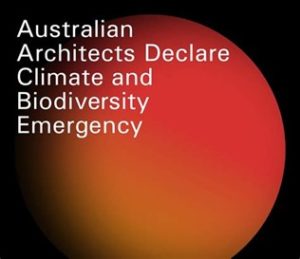Latest resources:
Sustainable Construction
Architects Declare Lunch + Learn | Evidence Based Design for Passive Performance with Paul Stoller | 28 Jun 2022
Video
Waste
Lunch + Learn with Architects Declare and Engineers Declare – Integrated design (1 Dec 2021)
Video
Regenerative Development | Lunch + Learn with Architects Declare and Dr Dominique Hes (6 Oct 2021)
Video
Wellbeing
First Steps in Reducing Embodied Carbon: applying new methods, tools and workflows – Lunch + Learn with Architects Declare, Scott Carver, Turner Studio, Architectus, HDR and Fitzpatrick + Partners (1 Sept 2021 recording)
Video

We aim to
Empower Architects to take responsibility and act
In a way that
We can realise our potential as a community of action
So that
We can be catalysts for regeneration of our ecosystems
The twin crises of climate breakdown and biodiversity loss are the most serious issue of our time. Globally, buildings and construction play a major part, accounting for nearly 40% of energy-related carbon dioxide (CO2) emissions whilst also having a significant impact on our natural habitats.
For everyone working in the construction industry, meeting the needs of our society without breaching the earth’s ecological boundaries will demand a paradigm shift in behaviour. Together with clients, architects need to commission and design buildings, cities and infrastructures as indivisible components of a larger, constantly regenerating and self-sustaining system.
The research and technology exist to begin that transformation now, but what has been lacking is collective will. Recognising this, AAD architects are committing to strengthen our working practices to create architecture and urbanism that has a more positive impact on the world around us.
In Australia, AAD architects are aware that Aboriginal and Torres Strait Islander peoples have long espoused the cultural, social, economic and environmental benefits embedded in the holistic relationship of Caring for Country.



Sustainability action plans
Australian Architects Declare Climate & Biodiversity Emergency
Web link
How to prepare your Sustainability Action Plan (Australian Architects Declare)
Video
Water
Introduction to Sustainability | Beginner | e-learning module
E-learning Module
Climate change
A pocket guide to climate change – ABC News
Web link
Sustainable Construction
Sustainability Victoria’s guide to Recycled Materials in Pavement Construction
Web link
Sustainable Procurement
Good Environmental Choice Australia’s ecolabel and recommendations for certified products
Web link
Sustainable Construction
Sustainable Design with the City of Port Phillip
Web link
Sustainable Procurement
Value of sustainable procurement practices
Web link
Sustainable Construction
Sustainable Design with the City of Whittlesea
Web link
Local community and economy
Fair Work Act (2009)
Web link
Embodied carbon
Wellbeing
First Steps in Reducing Embodied Carbon: applying new methods, tools and workflows – Lunch + Learn with Architects Declare, Scott Carver, Turner Studio, Architectus, HDR and Fitzpatrick + Partners (1 Sept 2021 recording)
Video
“Guide to Net Zero Embodied Carbon” Lunch + Learn with Architects Declare + The Footprint Company (4AUG2021 recording)
Video
Guide to Net Zero Embodied Carbon – Australian Architects Declare
Document / Presentation
Low embodied carbon in construction materials – what’s stopping us? – Lendlease
Document / Presentation
The Time Is Now: Tackling Embodied Carbon in the Building and Construction Sector – WWF
Document / Presentation
Local community and economy
Fair Work Act (2009)
Web link
Towards zero-carbon building (World Green Building Council)
Web link
Operational carbon
Sustainable Construction
Architects Declare Lunch + Learn | Evidence Based Design for Passive Performance with Paul Stoller | 28 Jun 2022
Video
Waste
ACT Government Territory and Municipal Services: Recycling & Waste Information Portal
Web link
Local community and economy
Victorian Government Social Procurement Framework and guides
Web link
Carbon and Energy
NSW Government’s Net Zero Plan Stage 1: 2020-2030
Document/Presentation
Waste
Good Enviromental Choice Australia’s (GECA’s) Recycled Products Standard
Web link
Materials
Program for the Endorsement of Forest Certification (PEFC)
Web link
4 key steps to writing a sustainable procurement policy – GECA
Web link
Local community and economy
Supply Nation Â
Web link
Materials
Construction and demolition waste guide – Recycling and re-use across the supply chain
Tool
Materials
Australian Forestry Standard
Web link
Local community and economy
Dow Jones Sustainability Index
Tool
Carbon and Energy
2006 IPCC Guidelines for National Greenshouse Gas Inventories
Web link
CO2e)
Greenhouse Gas Assessment Workbook for Road Projects
Tool
Carbon and Energy
United Nations Environmental Indicators
Tool
Carbon and Energy
Department of Environment: National Greenhouse Account Factors
Web link
Carbon and Energy
National Greenhouse and Energy Reporting System Management: Technical Guidelines for the Estimation of Greenhouse Gas Emissions By Facilities in Australia July 2013
Web link
Carbon and Energy
Australian National Pollutant Inventory (NPI)
Web link
Carbon and Energy
Australian Grenhouse Gas Emissions Information System (AGEIS)
Web link
Biodiversity
Australia’s Biodiversity Conservation Strategy
Web link
Regenerative design
On why our Renaissance needs to be a perfect circle, even if our politicians disagree – The Fifth Estate
Web link
Regenerative Development | Lunch + Learn with Architects Declare and Dr Dominique Hes (6 Oct 2021)
Video
The Regenerates
Web link
Regenerative Development | Regenesis Group
Video

 60 minutes
60 minutes